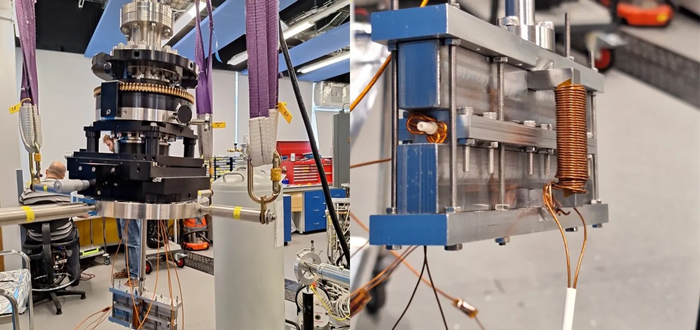Researchers at Swansea University have created a novel imaging approach for neutral atomic beam microscopes that allows for significantly faster acquisition of microscope images.

Left: The magnetic encoding device lifted by a crane before being attached to beam line. Right: A close-up of the magnetic encoding device before it was attached. The atomic beam enters the device through the hollow white ceramic tube shown. Image Credit: Morgan Lowe
Neutral atomic beam microscopes have become a key focus in scientific research due to their ability to image surfaces that commercial microscopes cannot, such as delicate samples like bacterial biofilms, ice films, or organic photovoltaic systems, which are often damaged or altered by electrons, ions, or photons.
These microscopes work by scattering a beam of low-energy neutral particles, typically helium atoms, from a surface to scan its structure and composition.
Currently, neutral atomic beam microscopes generate images by illuminating the material through a tiny pinhole, scanning the sample’s location, and capturing the dispersed beam to create an image. However, this method has a significant limitation: the imaging process is time-consuming because it measures one pixel at a time. Enhancing resolution by reducing the pinhole diameter drastically decreases the beam flux, leading to even longer measurement times.
This is where a recent study by Swansea University offers a promising solution. Professor Gil Alexandrowicz's research group in the Chemistry Department has developed a faster alternative to pinhole scanning.
They demonstrated this novel technology using a beam of helium-3 atoms, a rare light isotope of regular helium. The new approach involves sending an atom beam through a non-uniform magnetic field and using nuclear spin precession to encode the positions of the beam particles as they interact with the sample.
Morgan Lowe, a Ph.D. student on the Swansea team, designed the magnetic encoding device and conducted the first series of experiments to validate the new method. Remarkably, the measured beam profile closely matched numerical simulation results. The researchers also conducted further simulations, indicating that the magnetic encoding technique could significantly enhance image resolution while requiring much less time than the conventional pinhole microscopy method.
The method we have developed opens up various new opportunities in the field of neutral beam microscopy. It should make it possible to improve image resolution without requiring forbiddingly long measurement times, and also has the potential for enabling new contrast mechanisms based on the magnetic properties of the sample studied.
Gil Alexandrowicz, Study Lead Researcher and Professor, Chemistry, Swansea University
Alexandrowicz added, “In the immediate future the new method will be further developed to create a fully working prototype magnetic encoding neutral beam microscope. This will allow testing of the resolution limits, contrast mechanisms and operation modes of the new technique.”
“In the more distant future, this new type of microscope should become available to scientists and engineers to characterize the topography and composition of sensitive and delicate samples they produce and/or study,” Alexandrowicz concluded.
Journal Reference:
Lowe, M., et. al. (2024) Neutral beam microscopy with a reciprocal space approach using magnetic beam spin encoding. Nature Communications. doi.org/10.1038/s41467-024-51175-2